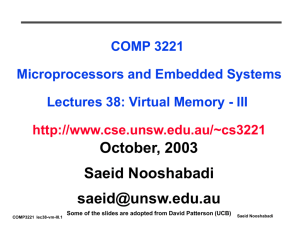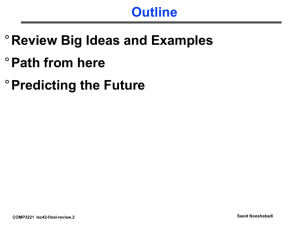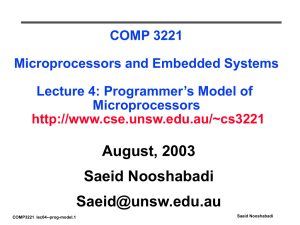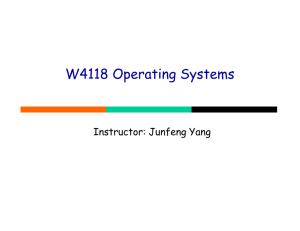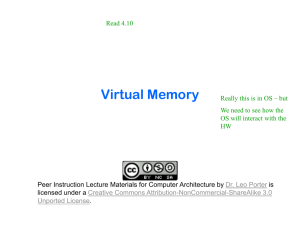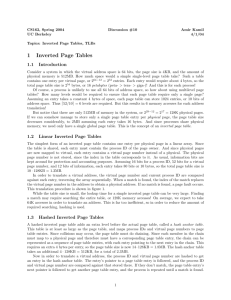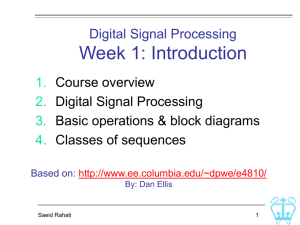ppt
advertisement
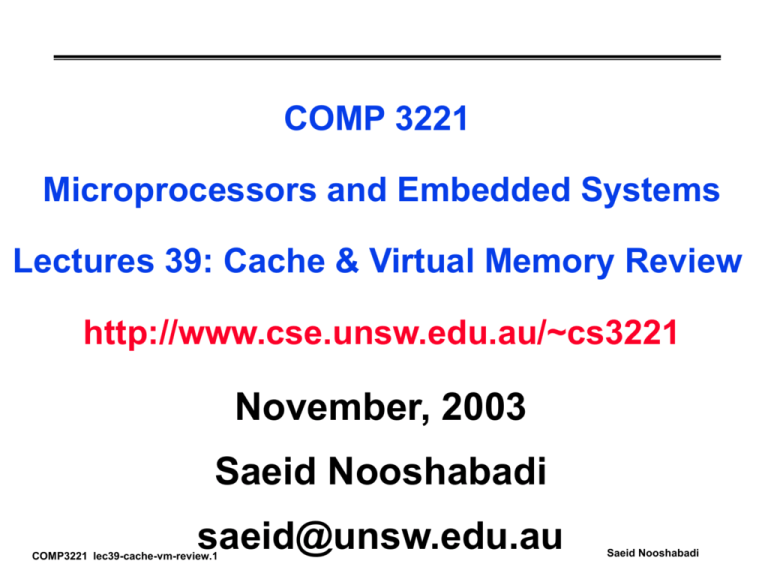
COMP 3221 Microprocessors and Embedded Systems Lectures 39: Cache & Virtual Memory Review http://www.cse.unsw.edu.au/~cs3221 November, 2003 Saeid Nooshabadi saeid@unsw.edu.au COMP3221 lec39-cache-vm-review.1 Saeid Nooshabadi Review (#1/3) °Apply Principle of Locality Recursively °Reduce Miss Penalty? add a (L2) cache °Manage memory to disk? Treat as cache • Included protection as bonus, now critical • Use Page Table of mappings vs. tag/data in cache °Virtual memory to Physical Memory Translation too slow? • Add a cache of Virtual to Physical Address Translations, called a TLB COMP3221 lec39-cache-vm-review.2 Saeid Nooshabadi Review (#2/3) °Virtual Memory allows protected sharing of memory between processes with less swapping to disk, less fragmentation than always swap or base/bound via segmentation °Spatial Locality means Working Set of Pages is all that must be in memory for process to run fairly well °TLB to reduce performance cost of VM °Need more compact representation to reduce memory size cost of simple 1-level page table (especially 32 - 64-bit addresses) COMP3221 lec39-cache-vm-review.3 Saeid Nooshabadi Why Caches? µProc 60%/yr. CPU “Moore’s Law” Processor-Memory Performance Gap: (grows 50% / year) DRAM DRAM 7%/yr. 100 10 1 1980 1981 1982 1983 1984 1985 1986 1987 1988 1989 1990 1991 1992 1993 1994 1995 1996 1997 1998 1999 2000 Performance 1000 ° 1989 first Intel CPU with cache on chip; ° 1999 gap “Tax”; 37% area of Alpha 21164, 61% StrongArm SA110, 64% Pentium Pro COMP3221 lec39-cache-vm-review.4 Saeid Nooshabadi Memory Hierarchy Pyramid Central Processor Unit (CPU) Increasing “Upper” Distance from CPU, Level 1 Levels in Decreasing memory Level 2 cost / MB hierarchy Level 3 “Lower” ... Level n Size of memory at each level Principle of Locality (in time, in space) + Hierarchy of Memories of different speed, cost; exploit to improve cost-performance COMP3221 lec39-cache-vm-review.5 Saeid Nooshabadi Why virtual memory? (#1/2) ° Protection • regions of the address space can be read only, execute only, . . . ° Flexibility • portions of a program can be placed anywhere, without relocation (changing addresses) ° Expandability • can leave room in virtual address space for objects to grow ° Storage management • allocation/deallocation of variable sized blocks is costly and leads to (external) fragmentation; paging solves this COMP3221 lec39-cache-vm-review.6 Saeid Nooshabadi Why virtual memory? (#2/2) ° Generality • ability to run programs larger than size of physical memory ° Storage efficiency • retain only most important portions of the program in memory ° Concurrent I/O • execute other processes while loading/dumping page COMP3221 lec39-cache-vm-review.7 Saeid Nooshabadi Virtual Memory Review (#1/4) °User program view of memory: • Contiguous • Start from some set address • Infinitely large • Is the only running program °Reality: • Non-contiguous • Start wherever available memory is • Finite size • Many programs running at a time COMP3221 lec39-cache-vm-review.8 Saeid Nooshabadi Virtual Memory Review (#2/4) °Virtual memory provides: • illusion of contiguous memory • all programs starting at same set address • illusion of infinite memory • protection COMP3221 lec39-cache-vm-review.9 Saeid Nooshabadi Virtual Memory Review (#3/4) °Implementation: • Divide memory into “chunks” (pages) • Operating system controls pagetable that maps virtual addresses into physical addresses • Think of memory as a cache for disk • TLB is a cache for the pagetable COMP3221 lec39-cache-vm-review.10 Saeid Nooshabadi Why Translation Lookaside Buffer (TLB)? °Paging is most popular implementation of virtual memory (vs. base/bounds in segmentation) °Every paged virtual memory access must be checked against Entry of Page Table in memory to provide protection °Cache of Page Table Entries makes address translation possible without memory access (in common case) to make translation fast COMP3221 lec39-cache-vm-review.11 Saeid Nooshabadi Virtual Memory Review (#4/4) °Let’s say we’re fetching some data: • Check TLB (input: VPN, output: PPN) - hit: fetch translation - miss: check pagetable (in memory) pagetable hit: fetch translation pagetable miss: page fault, fetch page from disk to memory, return translation to TLB • Check cache (input: PPN, output: data) - hit: return value - miss: fetch value from memory COMP3221 lec39-cache-vm-review.12 Saeid Nooshabadi Paging/Virtual Memory Review User A: Virtual Memory 0 Physical Memory 64 MB Stack User B: TLB Virtual Memory Stack Heap Heap Static Static Code A Page 0 Table COMP3221 lec39-cache-vm-review.13 B Page Code Table 0 Saeid Nooshabadi Three Advantages of Virtual Memory 1) Translation: • Program can be given consistent view of memory, even though physical memory is scrambled • Makes multiple processes reasonable • Only the most important part of program (“Working Set”) must be in physical memory • Contiguous structures (like stacks) use only as much physical memory as necessary yet still grow later COMP3221 lec39-cache-vm-review.14 Saeid Nooshabadi Three Advantages of Virtual Memory 2) Protection: • Different processes protected from each other • Different pages can be given special behavior - (Read Only, Invisible to user programs, etc). • Privileged data protected from User programs • Very important for protection from malicious programs Far more “viruses” under Microsoft Windows 3) Sharing: • Can map same physical page to multiple users (“Shared memory”) COMP3221 lec39-cache-vm-review.15 Saeid Nooshabadi 4 Questions for Memory Hierarchy ° Q1: Where can a block be placed in the upper level? (Block placement) ° Q2: How is a block found if it is in the upper level? (Block identification) ° Q3: Which block should be replaced on a miss? (Block replacement) ° Q4: What happens on a write? (Write strategy) COMP3221 lec39-cache-vm-review.16 Saeid Nooshabadi Q1: Where block placed in upper level? °Block 12 placed in 8 block cache: • Fully associative, direct mapped, 2-way set associative • S.A. Mapping = Block Number Mod Number of Sets Block no. 01234567 Fully associative: block 12 can go anywhere Block no. COMP3221 Block no. 01234567 Direct mapped: block 12 can go only into block 4 (12 mod 8) Block-frame address Block no. 01234567 Set Set Set Set 0 1 2 3 Set associative: block 12 can go anywhere in set 0 (12 mod 4) 1111111111222222222233 0 1 2 3 4 5 6 7 8 9 0 1 2 3 4 5 6 7 8 9 0 1 2 3 4 5 6 7 8 9 0 1Saeid Nooshabadi lec39-cache-vm-review.17 Q2: How is a block found in upper level? Block Address Tag Block offset Index Set Select Data Select °Direct indexing (using index and block offset), and tag comparing °Increasing associativity shrinks index, expands tag COMP3221 lec39-cache-vm-review.18 Saeid Nooshabadi Q3: Which block replaced on a miss? °Easy for Direct Mapped °Set Associative or Fully Associative: • Random • LRU (Least Recently Used) Miss Rates Associativity: 2-way Size 4-way LRU Ran LRU Ran 8-way LRU Ran 16 KB 5.2% 5.7% 4.7% 5.3% 4.4% 5.0% 64 KB 1.9% 2.0% 1.5% 1.7% 1.4% 1.5% 256 KB 1.15% 1.17% 1.13% 1.13% 1.12% 1.12% COMP3221 lec39-cache-vm-review.19 Saeid Nooshabadi Q4: What happens on a write? °Write through—The information is written to both the block in the cache and to the block in the lower-level memory. °Write back—The information is written only to the block in the cache. The modified cache block is written to main memory only when it is replaced. • is block clean or dirty? °Pros and Cons of each? • WT: read misses cannot result in writes • WB: no writes of repeated writes COMP3221 lec39-cache-vm-review.20 Saeid Nooshabadi 3D - Graphics For Mobile Phones ° Developed in collaboration with Imagination Technologies, MBX 2D and 3D accelerator cores deliver PC and console-quality 3D graphics on embedded ARMbased devices. ° Supporting the feature-set and performance-level of commodity PC hardware, MBX cores use a unique screen-tiling technology to reduce the memory bandwidth and power consumption to levels suited to mobile devices, providing excellent priceperformance for embedded SoC devices. ° ° ° ° °Up to 2.5 million triangle/sec rendering rate °Suited to QVGA (320x240) up to VGA (640x480) resolution screens °<1mW/MHz in 0.13µm process and <2mW in 0.18 µm process VGP floating point geometry 660K gates (870K with optional VGP °Optional engine compatible with Microsoft geometry processor) VertexShader specification 80MHz operation in 0.18µm process °2D and 3D graphics acceleration and video acceleration Over 120MHz operation in 0.13µm °Screen tiling and deferred texturing - only process visible pixels are rendered Up to 500 mega pixel/sec effective fill °Internal Z-buffer tile within the MBX core Saeid Nooshabadi COMP3221 lec39-cache-vm-review.21 rate http://news.zdnet.co.uk/0,39020330,39117384,00.htm Address Translation & 3 Exercises Virtual Address VPN-tag INDEX Offset TLB ... PPN Physical TLB- tag Page Number TLB-tag PPN TLB-tag PPN TLB-tag PPN Offset Physical Address = VPN = VPN-tag + Index Hit COMP3221 lec39-cache-vm-review.22 Saeid Nooshabadi Address Translation Exercise 1 (#1/2) °Exercise: • 40-bit VA, 16 KB pages, 36-bit PA °Number of bits in Virtual Page Number? °a) 18; b) 20; c) 22; d) 24; e) 26 26; f) 28 °Number of bits in Page Offset? • a) 8; b) 10; c) 12; d) 14 14; e) 16; f) 18 °Number of bits in Physical Page Number? • a) 18; b) 20; c) 22 22; d) 24; e) 26; f) 28 COMP3221 lec39-cache-vm-review.23 Saeid Nooshabadi Address Translation Exercise 2 (#1/2) °Exercise: • 40-bit VA, 16 KB pages, 36-bit PA • 2-way set-assoc TLB: 256 "slots", 2 per slot °Number of bits in TLB Index? a) 8 8; b) 10; c) 12; d) 14; e) 16; f) 18 °Number of bits in TLB Tag? a) 18 18; b) 20; c) 22; d) 24; e) 26; f) 28 °Approximate Number of bits in TLB Entry? a) 32; b) 36; c) 40; d) 42; e) 44; f) 46 COMP3221 lec39-cache-vm-review.25 Saeid Nooshabadi Address Translation Exercise 3 (#1/2) °Exercise: • 40-bit VA, 16 KB pages, 36-bit PA • 2-way set-assoc TLB: 256 "slots", 2 per slot • 64 KB data cache, 64 Byte blocks, 2 way S.A. °Number of bits in Cache Offset? a) 6 6; b) 8; c) 10; d) 12; e) 14; f) 16 °Number of bits in Cache Index? a) 6; b) 9 9; c) 10; d) 12; e) 14; f) 16 °Number of bits in Cache Tag? a) 18; b) 20; c) 21; 21 d) 24; e) 26; f) 28 °Approximate No. of bits in Cache Entry? COMP3221 lec39-cache-vm-review.27 Saeid Nooshabadi Cache/VM/TLB Summary: (#1/3) ° The Principle of Locality: • Program access a relatively small portion of the address space at any instant of time. - Temporal Locality: Locality in Time Spatial Locality: Locality in Space ° Caches, TLBs, Virtual Memory all understood by examining how they deal with 4 questions: 1) Where can block be placed? 2) How is block found? 3) What block is replaced on miss? 4) How are writes handled? COMP3221 lec39-cache-vm-review.29 Saeid Nooshabadi Cache/VM/TLB Summary: (#2/3) °Virtual Memory allows protected sharing of memory between processes with less swapping to disk, less fragmentation than always swap or base/bound in segmentation °3 Problems: 1) Not enough memory: Spatial Locality means small Working Set of pages OK 2) TLB to reduce performance cost of VM 3) Need more compact representation to reduce memory size cost of simple 1-level page table, especially for 64-bit address (See COMP3231) COMP3221 lec39-cache-vm-review.30 Saeid Nooshabadi Cache/VM/TLB Summary: (#3/3) °Virtual memory was controversial at the time: can SW automatically manage 64KB across many programs? • 1000X DRAM growth removed controversy °Today VM allows many processes to share single memory without having to swap all processes to disk; VM protection today is more important than memory hierarchy °Today CPU time is a function of (ops, cache misses) vs. just f(ops): What does this mean to Compilers, Data structures, Algorithms? COMP3221 lec39-cache-vm-review.31 Saeid Nooshabadi
